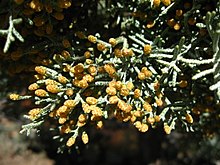Hesperocyparis glabra
Appearance
| Hesperocyparis glabra | |
|---|---|

| |
| Male pollen cones | |
| Scientific classification | |
| Kingdom: | Plantae |
| Clade: | Tracheophytes |
| Clade: | Gymnospermae |
| Division: | Pinophyta |
| Class: | Pinopsida |
| Order: | Cupressales |
| Family: | Cupressaceae |
| Genus: | Cupressus |
| Species: | |
| Variety: | C. a. var. glabra
|
| Trinomial name | |
| Cupressus arizonica var. glabra | |

| |
| Natural range of Cupressus arizonica var. glabra | |
| Synonyms[2] | |
| |
Cupressus arizonica var. glabra, known as the Arizona smooth bark cypress or smooth Arizona cypress, is a conifer native to the American Southwest, with a range stretching over the canyons and slopes in a somewhat wide vicinity around Sedona, Arizona. It was first described by George Bishop Sudworth in 1910.[3]
It is distinguished from Cupressus arizonica var. arizonica by its very smooth, non-furrowed bark which can appear in shades of pink, cherry, and grey.[citation needed]
It is often seen in cultivation, as unlike Monterey Cypress, it has proved almost immune to Cypress Canker.
References
- Wolf, C. B. & Wagener, W. E. (1948). The New World cypresses. El Aliso 1: 195–205.
- ^ Farjon, A. (2011). "'Cupressus arizonica var. glabra'". IUCN Red List of Threatened Species. 2011. Retrieved 2 February 2016.
{{cite journal}}: Invalid|ref=harv(help) - ^ The Plant List: A Working List of All Plant Species, retrieved 24 September 2016
- ^ "Cupressus glabra". International Plant Names Index (IPNI). Royal Botanic Gardens, Kew; Harvard University Herbaria & Libraries; Australian National Botanic Gardens. Retrieved 24 February 2010.
External links
 Media related to Cupressus glabra at Wikimedia Commons
Media related to Cupressus glabra at Wikimedia Commons- Cupressus.net: Cupressus glabra
- Gymnosperm database.org: Cupressus glabra

